Castello Aragonese
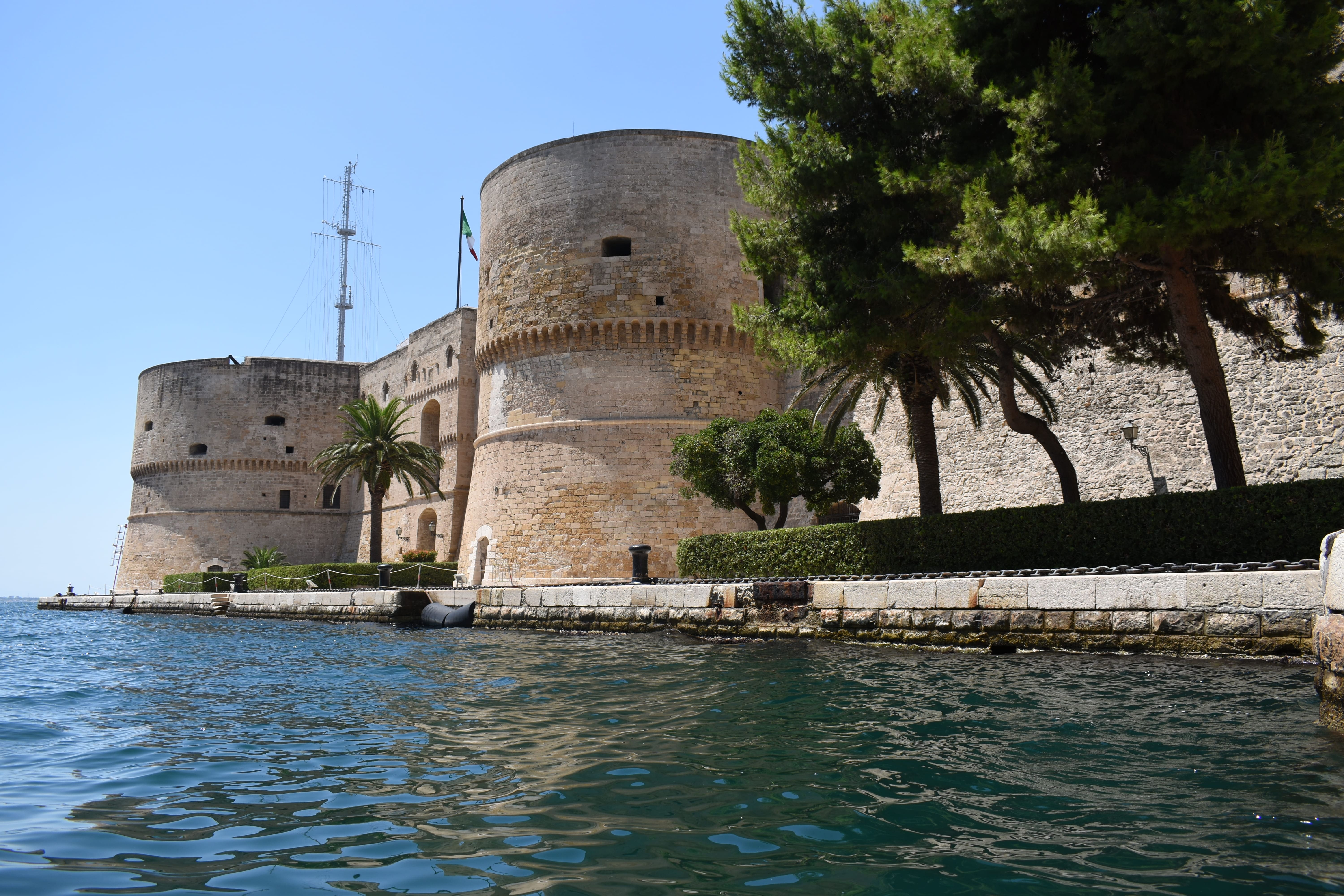
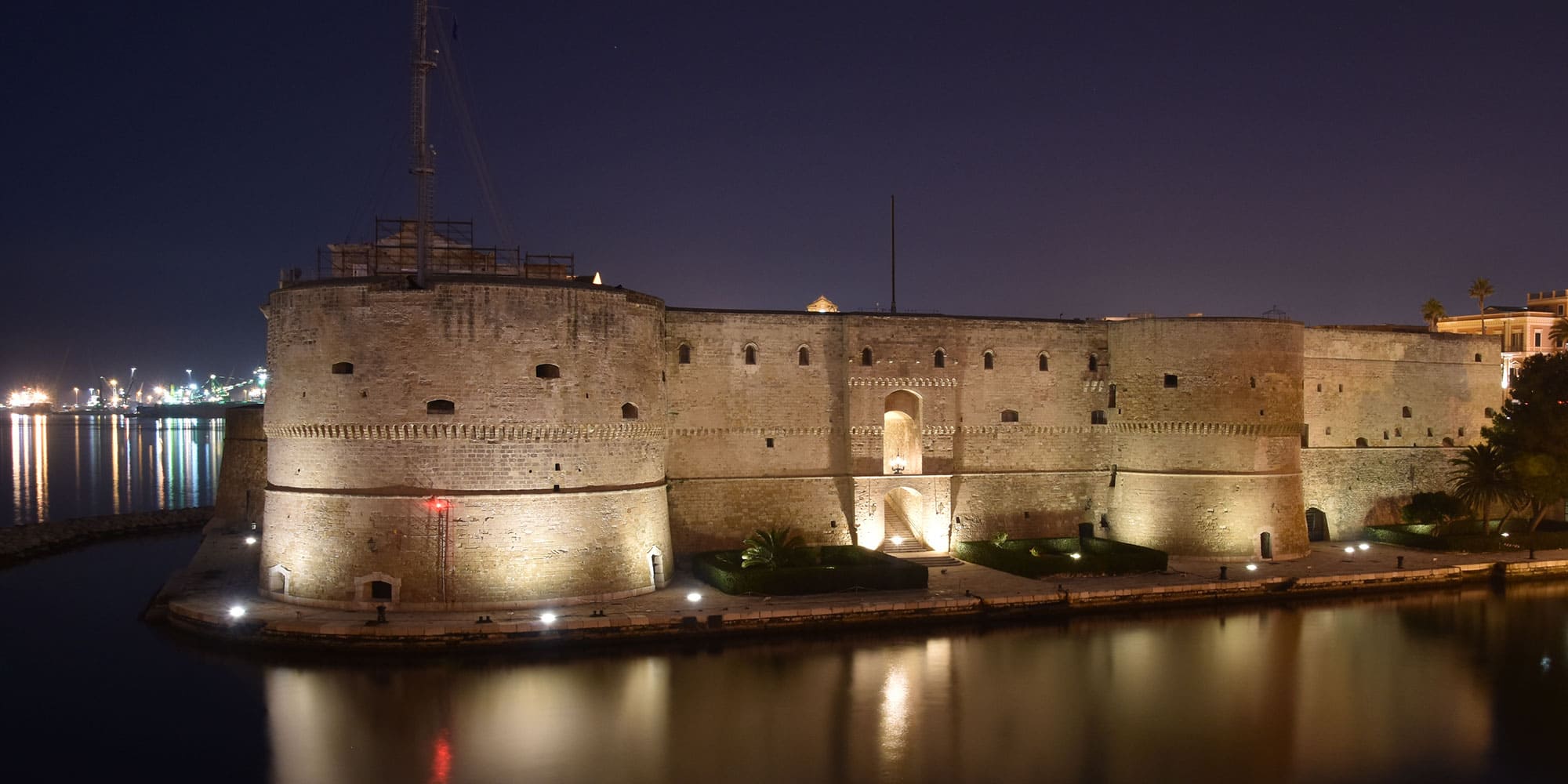
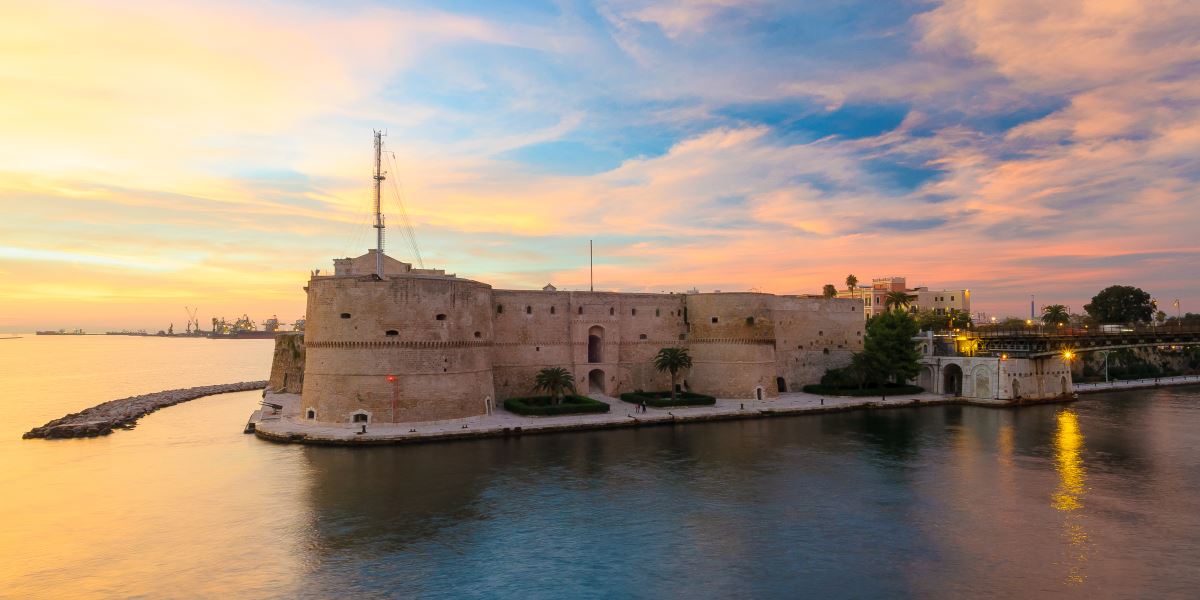
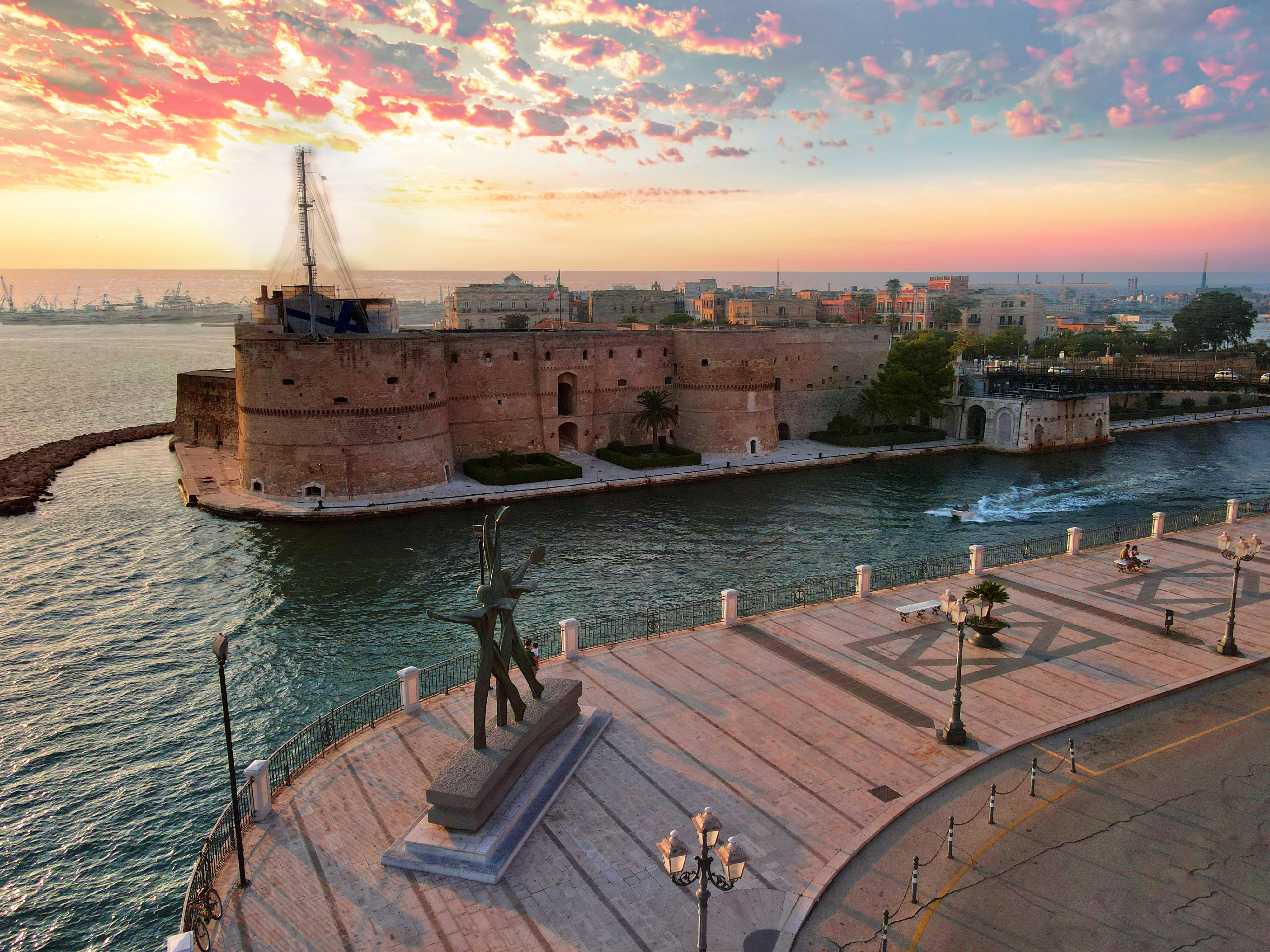
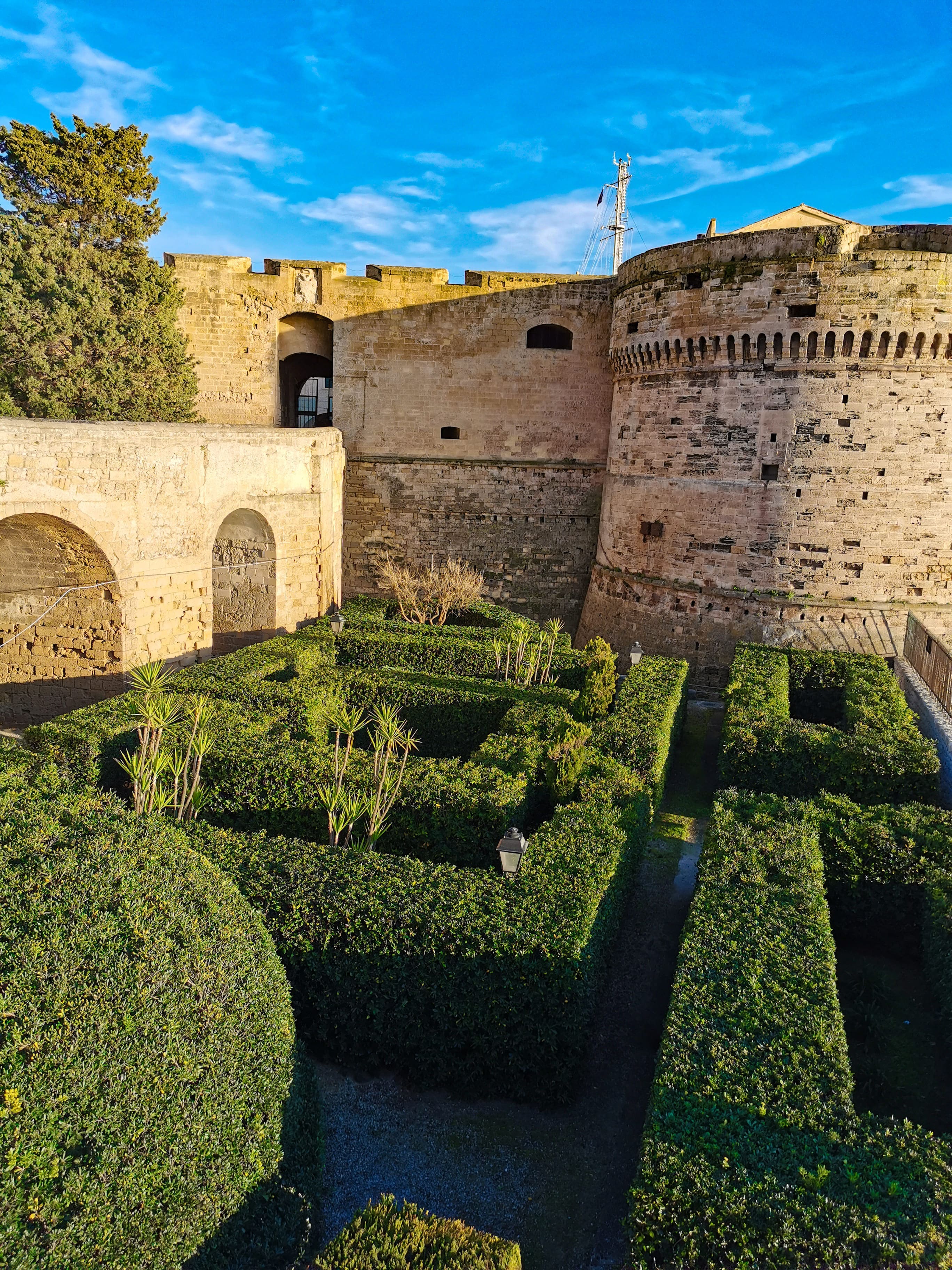
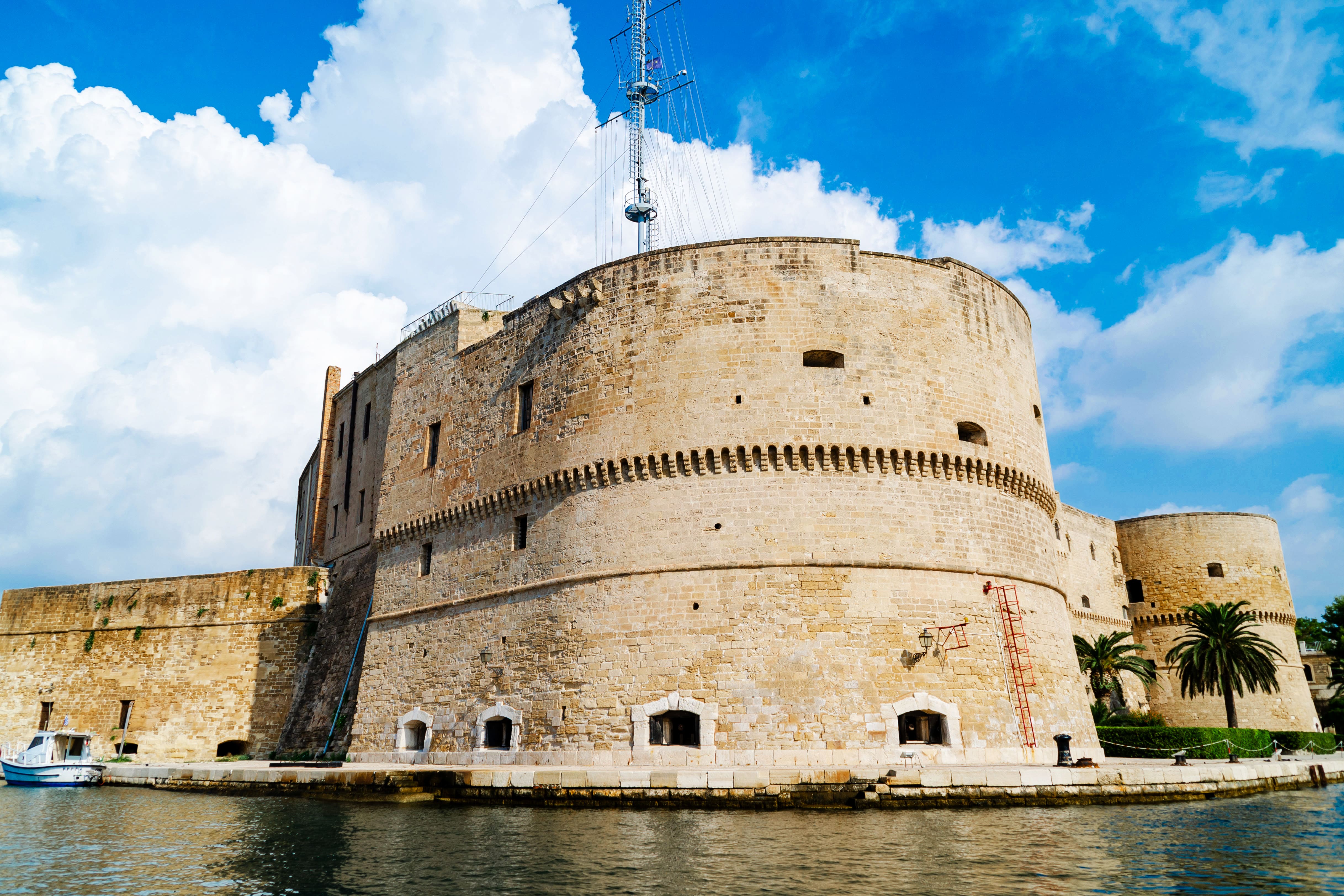
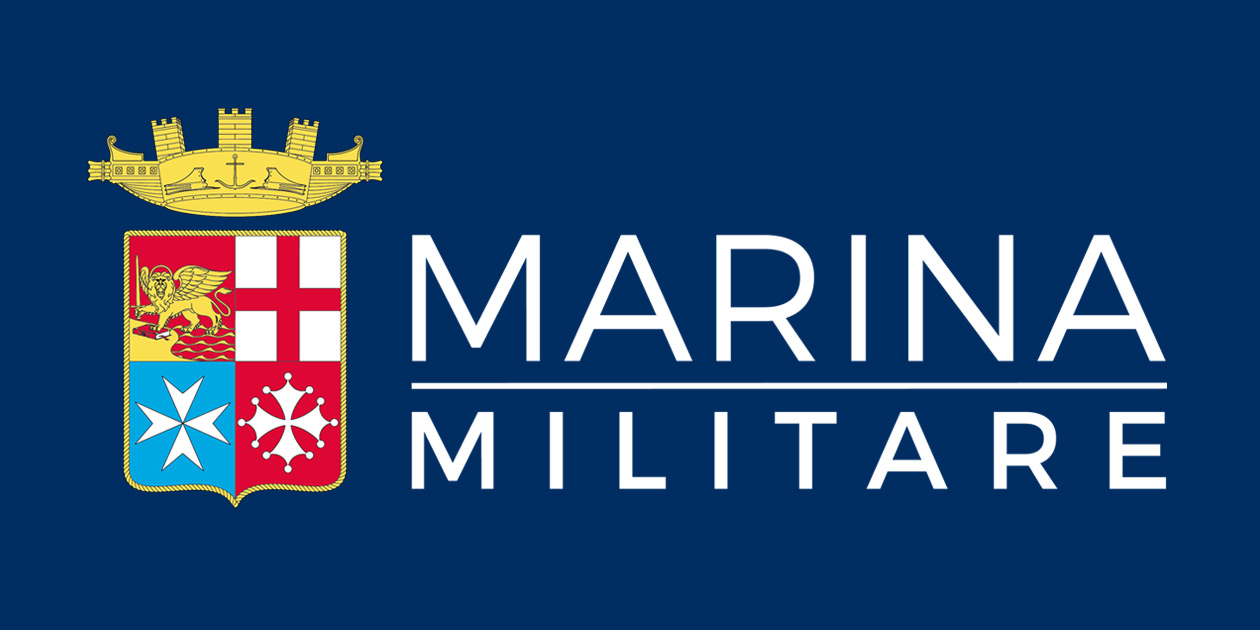
Aragonese Castle
Noble palaces
The Castle of Taranto, called Castel S. Angelo, is located near an ancient natural depression of the rock bank above which the ancient village of the city rises and consists of an Aragonese reconstruction of a previous Norman-Swabian-Angevin fortress built in the same point but with very different characteristics since it was a typical medieval castle with numerous tall and thin towers built over a previous Byzantine fortification that had the foundations resting on structures dating back to the Greek period (IV-III century BC).
The improvement of artillery in the 15th century made medieval castles obsolete as their thin walls could no longer withstand the guns of the attackers or allow their use by the defenders. The conquest of Otranto by the Turks in 1480 clearly demonstrated that this type of fortification was by now inadequate. The king of Naples, Ferdinand of Aragon, therefore decided to reinforce the coastal defenses of the kingdom. In this context, between 1487 and 1492, the Castle of Taranto was rebuilt perhaps following the specific project of the great Sienese architect Francesco di Giorgio.
The new castle had a vaguely reminiscent shape of a scorpion with five round towers located at the corners of the building. These towers, lower and wider than the previous ones, received the name of S. Cristoforo, San Lorenzo and Sant 'Angelo for the three in front of the current navigable canal, while the two in front of the ancient village were called Annunziata and Bandiera. Towers and walls were the same height, 21 meters, and almost the same thickness, about 8 meters; all the towers had a diameter of 18 meters except San Cristoforo which was 10 meters wider. Towards the Mar Grande, in accordance with the probable project of Francesco di Giorgio, a triangular strut was added in 1491 (a true prototype of the 16th century bastion, erroneously called the ravelin), to reinforce the southern curtain and improve the defense capacity flanking the access to the moat which was enlarged to connect the Mar Grande with the Mar Piccolo. The fortifications of the fifteenth century. they had high aesthetic qualities but a rather ephemeral military validity due to the rapid progress of artillery.
The Spaniards, who succeeded the Aragonese in 1502, enlarged the summit platforms to facilitate the movement and use of artillery. They also filled many of the intramural tunnels and the upper casemates of the towers with earth to reinforce them and to obtain gun emplacements on the top of the towers.
Despite the Spanish interventions, the fortress gradually lost military validity and after having played a fundamental role in numerous battles, in particular repelling the Turkish assault in 1594, it ended up being used as a prison and as a barracks. This different use has led to the fragmentation of the internal rooms with the closure of passages and corridors. In addition to this, the increased residential needs combined with the low cost of plaster and concrete, have led to the massive use of these materials to cover walls and floors in order to improve hygienic conditions. The castle, however, remained substantially intact except for the tower of S. Angelo, which was demolished in 1883 to make room for the swing bridge. Starting from 2003, the Navy, guardian of the castle since 1883, began the systematic restoration of the interior of the fortress with the aim of bringing it back to the Aragonese configuration and identifying the previous Greek, Byzantine, Norman, Swabian-Angevin structures. The internal restoration, carried out by the staff of the Navy, under the supervision of the local Superintendency of Architectural Heritage, essentially consists in the removal of plaster and cement to bring to light the original surfaces of walls and floors in the reopening of corridors, rooms and passages, in addition, to re-establish the permeability of the castle and restore the functionality of the various defensive elements. During these activities, large quantities of earth were excavated in collaboration with the University of Bari, under the supervision of the Superintendency of Archaeological Heritage, leading to the discovery of numerous finds from different periods that span almost three thousand years of history.
The Castle of Taranto, called Castel S. Angelo, is located near an ancient natural depression of the rock bank above which the ancient village of the city rises and consists of an Aragonese reconstruction of a previous Norman-Swabian-Angevin fortress built in the same point but with very different characteristics since it was a typical medieval castle with numerous tall and thin towers built over a previous Byzantine fortification that had the foundations resting on structures dating back to the Greek period (IV-III century BC).
The improvement of artillery in the 15th century made medieval castles obsolete as their thin walls could no longer withstand the guns of the attackers or allow their use by the defenders. The conquest of Otranto by the Turks in 1480 clearly demonstrated that this type of fortification was by now inadequate. The king of Naples, Ferdinand of Aragon, therefore decided to reinforce the coastal defenses of the kingdom. In this context, between 1487 and 1492, the Castle of Taranto was rebuilt perhaps following the specific project of the great Sienese architect Francesco di Giorgio.
The new castle had a vaguely reminiscent shape of a scorpion with five round towers located at the corners of the building. These towers, lower and wider than the previous ones, received the name of S. Cristoforo, San Lorenzo and Sant 'Angelo for the three in front of the current navigable canal, while the two in front of the ancient village were called Annunziata and Bandiera. Towers and walls were the same height, 21 meters, and almost the same thickness, about 8 meters; all the towers had a diameter of 18 meters except San Cristoforo which was 10 meters wider. Towards the Mar Grande, in accordance with the probable project of Francesco di Giorgio, a triangular strut was added in 1491 (a true prototype of the 16th century bastion, erroneously called the ravelin), to reinforce the southern curtain and improve the defense capacity flanking the access to the moat which was enlarged to connect the Mar Grande with the Mar Piccolo. The fortifications of the fifteenth century. they had high aesthetic qualities but a rather ephemeral military validity due to the rapid progress of artillery.
The Spaniards, who succeeded the Aragonese in 1502, enlarged the summit platforms to facilitate the movement and use of artillery. They also filled many of the intramural tunnels and the upper casemates of the towers with earth to reinforce them and to obtain gun emplacements on the top of the towers.
Despite the Spanish interventions, the fortress gradually lost military validity and after having played a fundamental role in numerous battles, in particular repelling the Turkish assault in 1594, it ended up being used as a prison and as a barracks. This different use has led to the fragmentation of the internal rooms with the closure of passages and corridors. In addition to this, the increased residential needs combined with the low cost of plaster and concrete, have led to the massive use of these materials to cover walls and floors in order to improve hygienic conditions. The castle, however, remained substantially intact except for the tower of S. Angelo, which was demolished in 1883 to make room for the swing bridge. Starting from 2003, the Navy, guardian of the castle since 1883, began the systematic restoration of the interior of the fortress with the aim of bringing it back to the Aragonese configuration and identifying the previous Greek, Byzantine, Norman, Swabian-Angevin structures. The internal restoration, carried out by the staff of the Navy, under the supervision of the local Superintendency of Architectural Heritage, essentially consists in the removal of plaster and cement to bring to light the original surfaces of walls and floors in the reopening of corridors, rooms and passages, in addition, to re-establish the permeability of the castle and restore the functionality of the various defensive elements. During these activities, large quantities of earth were excavated in collaboration with the University of Bari, under the supervision of the Superintendency of Archaeological Heritage, leading to the discovery of numerous finds from different periods that span almost three thousand years of history.
explore the castle from your smartphone
Start exploring part of the Castle through the Virtual Tour. You will be able to perceive the historical and cultural heritage that characterizes the Aragonese Castle of Taranto
Guided tour
The Navy carries out free guided tours of the Castle every day of the year (including holidays). Reservations are required by calling 099 775 3438
Tourist route
Discover the recommended tourist route to visit the Castle and the other points of historical and cultural interest in the immediate vicinity
Historical Navy Exhibition
In the heart of Taranto, an unmissable exhibition that will accompany you through the stories, vehicles and equipment of the Navy, to discover a past full of fascinating curiosities
Sacello Romano
Do you want to continue the tour? Discover the historic garden and the archaeological area (Sacello Romano) located in the Navy Hospital of Taranto
Nearby
Do you want to continue the tour? The Cathedral of San Cataldo is not far away! Discover the artistic and cultural heritage of the Taranto Cathedral just a few steps away
Sea Experiences
If you want to live Taranto at 360 °, do not miss the experiences available! Do you want to reach the dolphins with the Jonian Dolphin Conservation or just spend a day on a sailing boat? Discover Taranto Capitale di Mare
Aragonese Castle
Noble palaces
The Castle of Taranto, called Castel S. Angelo, is located near an ancient natural depression of the rock bank above which the ancient village of the city rises and consists of an Aragonese reconstruction of a previous Norman-Swabian-Angevin fortress built in the same point but with very different characteristics since it was a typical medieval castle with numerous tall and thin towers built over a previous Byzantine fortification that had the foundations resting on structures dating back to the Greek period (IV-III century BC).
The improvement of artillery in the 15th century made medieval castles obsolete as their thin walls could no longer withstand the guns of the attackers or allow their use by the defenders. The conquest of Otranto by the Turks in 1480 clearly demonstrated that this type of fortification was by now inadequate. The king of Naples, Ferdinand of Aragon, therefore decided to reinforce the coastal defenses of the kingdom. In this context, between 1487 and 1492, the Castle of Taranto was rebuilt perhaps following the specific project of the great Sienese architect Francesco di Giorgio.
The new castle had a vaguely reminiscent shape of a scorpion with five round towers located at the corners of the building. These towers, lower and wider than the previous ones, received the name of S. Cristoforo, San Lorenzo and Sant 'Angelo for the three in front of the current navigable canal, while the two in front of the ancient village were called Annunziata and Bandiera. Towers and walls were the same height, 21 meters, and almost the same thickness, about 8 meters; all the towers had a diameter of 18 meters except San Cristoforo which was 10 meters wider. Towards the Mar Grande, in accordance with the probable project of Francesco di Giorgio, a triangular strut was added in 1491 (a true prototype of the 16th century bastion, erroneously called the ravelin), to reinforce the southern curtain and improve the defense capacity flanking the access to the moat which was enlarged to connect the Mar Grande with the Mar Piccolo. The fortifications of the fifteenth century. they had high aesthetic qualities but a rather ephemeral military validity due to the rapid progress of artillery.
The Spaniards, who succeeded the Aragonese in 1502, enlarged the summit platforms to facilitate the movement and use of artillery. They also filled many of the intramural tunnels and the upper casemates of the towers with earth to reinforce them and to obtain gun emplacements on the top of the towers.
Despite the Spanish interventions, the fortress gradually lost military validity and after having played a fundamental role in numerous battles, in particular repelling the Turkish assault in 1594, it ended up being used as a prison and as a barracks. This different use has led to the fragmentation of the internal rooms with the closure of passages and corridors. In addition to this, the increased residential needs combined with the low cost of plaster and concrete, have led to the massive use of these materials to cover walls and floors in order to improve hygienic conditions. The castle, however, remained substantially intact except for the tower of S. Angelo, which was demolished in 1883 to make room for the swing bridge. Starting from 2003, the Navy, guardian of the castle since 1883, began the systematic restoration of the interior of the fortress with the aim of bringing it back to the Aragonese configuration and identifying the previous Greek, Byzantine, Norman, Swabian-Angevin structures. The internal restoration, carried out by the staff of the Navy, under the supervision of the local Superintendency of Architectural Heritage, essentially consists in the removal of plaster and cement to bring to light the original surfaces of walls and floors in the reopening of corridors, rooms and passages, in addition, to re-establish the permeability of the castle and restore the functionality of the various defensive elements. During these activities, large quantities of earth were excavated in collaboration with the University of Bari, under the supervision of the Superintendency of Archaeological Heritage, leading to the discovery of numerous finds from different periods that span almost three thousand years of history.
contacts
Piazza Castello 4, Taranto
castelloaragonesetaranto.com
infocastelloaragonese@libero.it
099 775 3438
useful information
accessible
60 minutes
- Monday: 9:00 am - 1:00 am
- Tuesday: 9:00 am - 1:00 am
- Wednesday: 9:00 am - 1:00 am
- Thursday: 9:00 am - 1:00 am
- Friday: 9:00 am - 1:00 am
- Saturday: 9:00 am - 1:00 am
- Sunday: 9:00 am - 1:00 am